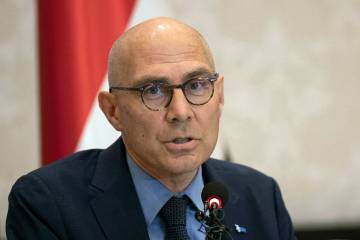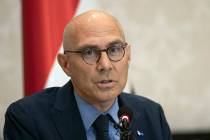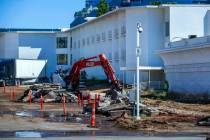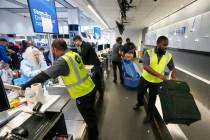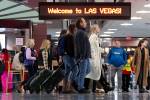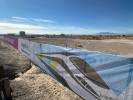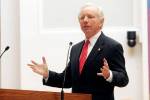DesertXpress plan clears environmental hurdle
The DesertXpress became the first high-speed rail project in the United States to complete the environmental impact study phase, bringing it closer to reality than any other proposal, federal officials said Friday.
"Passenger rail is on its way back to America. We're catching up," said U.S. Sen. Harry Reid, D-Nev. "We're going to catch up with the rest of the world. This project right here will be written about in textbooks."
DesertXpress is a steel-wheeled train that would travel in the median of Interstate 15 or alongside the highway, according to the environmental report released earlier this month. It would travel at speeds of up to 150 mph and transport passengers between Las Vegas and Victorville, Calif., in an hour and 20 minutes.
Reid said now that the study is completed, the public will have 30 days to comment. If the process moves along smoothly and the project is successful in securing a federal loan, construction could begin within a year, Reid said. The 200-mile line would be funded by private investors and public money , he said.
Critics have blasted the DesertXpress proposal because of a terminus location of Victorville, a high-desert community about 80 miles east of Los Angeles. They argued that air fare might be less expensive than the $50 to $55 one-way trip on DesertXpress.
Reid, accompanied by U.S. Secretary of Transportation Ray LaHood, emphasized that the line would eventually continue to Palmdale, Calif., where it would hook up with a planned high-speed rail network stretching from San Diego to Sacramento.
Aside from construction, the environmental impact study is the most time-consuming phase of the $6 billion project. After the study and public comments are reviewed and the DesertXpress organizers submit mitigation plans, a record of decision will be issued and work on the rail can begin.
"It begins the countdown to approval of this significant project," LaHood said of the completion of the environmental process, which began six years ago.
The study looks at effects to species and the use of sensitive lands, such as the Mojave National Preserve, as well as potential effects on archeological resources. It also examines the effects the train will have on pollution and traffic.
The report acknowledged the line will adversely affect biological aspects of the desert and some communities, but added that measures can be taken to reduce the impact. The final route and decision on the project will be made by the Federal Railroad Administration.
Although Nevada didn't receive any of the money, LaHood credited Reid with working closely with President Barack Obama in securing $8 billion for high-speed rail projects. Reid said he expects Nevada to secure federal money during the next funding phase, if it is approved.
If the project moves forward, it will create 34,000 jobs, LaHood said.
"These rail opportunities become an economic engine in creating more jobs," he said.
Reid initially backed magnetic levitation technology and a proposal to build a maglev train that would whisk travelers from Las Vegas to Anaheim, Calif., in 81 minutes at speeds of 300 mph. He withdrew his support two years ago, saying the technology is far too pricey and progress lagged.
He diverted $45 million he had earmarked for the Maglev project to a new interchange between Interstate 215 and the airport connector.
Maglev representatives vowed to move forward with their plan even if the DesertXpress effort continues.
A year ago, the Export-Import Bank of China offered the American Magline Group a $7 billion loan to build the Maglev train with the caveat the U.S. government reimburse it if the high-speed line failed.
When asked about the American Magline proposal on Friday, Reid said, "Maglev is not what I'm involved in. Its time has passed."
The entire environmental impact study is available at the Clark County Library, 1401 Flamingo Road.
Contact reporter Adrienne Packer at apacker@reviewjournal.com or 702-387-2904.
JOHN GURZINSKI/LAS VEGAS REVIEW-JOURNAL
Senate Majority Leader Harry Reid, D-Nev., walks past a model of the DesertXpress terminal planned in Victorville, Calif., one terminus of a high-speed train to Las Vegas. Reid joined U.S. Secretary of Transportation Ray LaHood on Friday to announce that the train is the first in the country to complete its environmental impact study.







